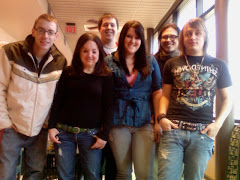

We've all been in at least one group before in our educational careers, but have you ever thought about how the group dynamics were formed? We came across an article by JS Atherton describing Tuckman's model for the formation of groups. Knowing how groups form will help you prepare for the next time you need to work in a small group by breaking down the steps involved and actions expected from the individuals.
The model consists of 4 stages:

1.) FORMING - This is the first stage in Tuckman's model for group development. This stage is where members first come together and begin forming relationships. Some shy members will remain reserved and quiet for this portion of the group process, while more outgoing members may emerge as group leaders. For our group, this stage meant getting to know each other's strengths and weaknesses and determining group roles.

2.) STORMING - This is the most uncomfortable stage in the group process, according to Atherton. During this stage, members may face a struggle for power and leaders who emerged during the forming stage may not retain their position. Many arguments may occur during this stage as well. For our group this meant reestablishing leadership positions after a rocky start. This also meant recognizing weaknesses within the group and compensating for the weaknesses.

3.) NORMING - During this stage, group norms are determined. The group gains its identity. This might include coming up with a group name or something that makes the group become a whole. For us, this meant taking a group photo, coming up with a group name, and designating group roles.

4.) PERFORMING - This is the most obvious stage. It's time to get the work done!
Have you ever been in a group situation where this model didn't apply? What was your unconventional group like?
Sources:
- Atherton, J S (2009) Learning and Teaching; Group Development [On-line] UK: Available: http://www.learningandteaching.info/teaching/group_development.htm
Accessed: 17 February 2010
- Tuckman, B (1965) "Developmental Sequence in Small Groups" Psychological Bulletin 63 pp. 384-399
- Group Development. http://www.learningandteaching.info/teaching/group_development.htm

Our current group for our blog doesn't seem to fit this honestly. We have formed and performed, but there has been no storming or norming. (That previous sentence sounds ridiculous.) There was no fight for control of leadership, and we often rotate our jobs, so there are no set roles. (We have group identity but thats about it.)
ReplyDeleteOn your article itself, we found it very interesting and well written. This model was unkown to us till now. A special note from Judd: I love the Kramer and Bumblebee pictures.